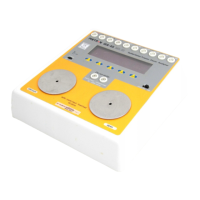ECG curves are generated by the microprocessor based on data
tables. The processor updates the 8-bit D/A-converter in IC1
(channel A), usually 500 times per second. IC-3 converts cur-
rent to voltage, and IC-2 makes the signal bipolar. The ampli-
tude is adjusted using P1, and the zero point is adjusted using
P4. From pin 1 on IC2 (TP-1) the stimulus signal is led via ca-
bles to resistive voltage dividers on the ECG signal distribution
card.
IC1 D/A-converter part B sets the reference level for the curve
generator D/A-converter part A. Part B thus determines the am-
plitude of the stimulus signal. The DC value for maximum am-
plitude is read back by the microprocessor's 10-bit A/D-input
El, and can therefore be adjusted precisely.
The other half of IC2 is used for operating the high-level output
for the ECG signal. The circuit has an amplification of 4 times.
The signal is filtered for high frequency noise with F18 before it
is conducted to contact J8. C3 ensures bandwidth limitation in
IC2. D9 is over voltage protection.
4. Power Supply (Schematic Diagram 2).
The unit is powered either from 2 internal 9V batteries or from
an external 9V DC power supply. The batteries are connected in
parallel via J6 and J10, while the external power supply can be
connected to J7. D1 protects against incorrect polarization. R16
is a PTC fuse that provides high impedance if too much power
is drawn. F19 provides high-frequency filtering and protects
against voltage transients from the power supply. The supply
voltage is conducted to the sensor board through the power
switch and back. F23 and F24 ensure reduction of high-fre-
quency radiation from the power supply cables.
After the power switch SW108, the supply voltage is conducted
to the power supply circuits. The supply voltage is also used di-
rectly as internal +9V. IC5 is a capacitive switch regulator that
regulates -9V from the +9V. These voltages will alternate, and
may vary from 7V to 12V.
IC4 is a series regulator that supplies the circuits with +5V. The
circuit has an output that resets the micro controller when the
+5V voltage falls below 4.75V. D6 and C13 provide the printer
output with its own +5V. D6 will block power inflow through
the printer cable when the QA-45 is switched off.
D7 and D8 rectify an AC signal from pin 2 IC-5, and build up a
voltage of -18V via C29. From this voltage, IC17 generates bias
voltage to the LCD display. The bias voltage is about -7V, and
is adjusted using P2 to set the contrast of the display.
5. Microprocessor (Schematic Diagram 3).
The microprocessor IC13 contains the CPU, RAM, A/D-con-
verter, parallel I/O and serial I/O. Y1 functions as a clock and
2

